|
| |
    


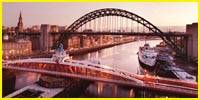

The North East of England 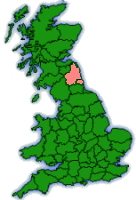
Not all flat caps and pigeons!
The North East is one of Britain’s most
attractive regions, famous for its miles of beautiful and unspoiled scenery, historic
castles and cathedrals and its rich industrial heritage. You can be on the beach or in the
country in only a few minutes.
There are two National Parks in the region: Northumberland National Park (Cheviot Hills
and Hadrian’s Wall country) in the north and the North York Moors National Park in
the south. A little further afield, to the west, lies another National Park - The English Lake
District, only a short railway journey away (along the attractive Tyne valley).
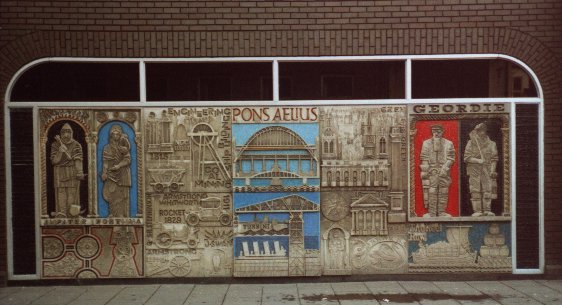
There is a particularly rich Roman, religious and industrial heritage in the North
East. The most prolific early builders were the Romans, who marked the northern extent of
their Empire by building Hadrian’s Wall - coast to coast across the North of England. The wall starts on the
River Tyne, just a few miles East of Newcastle at Wallsend. The region is rich in dramatic
castles and forts, erected over the centuries to guard against the succession of invaders who swept the land;
Romans, Vikings, Normans and Picts; many of them are in spectacular locations.
The industrial heritage of the North Fast is equally interesting. The region played a
leading role in the Industrial Revolution and was home to such men of genius as George
Stephenson (father of the railways), Sir Joseph Swan (inventor of the lightbulb, born in
Sunderland) and Sir Charles Parsons (inventor of the steam turbine). This rich heritage is
brought to life in the regions many museums, including the award winning Beamish open-air
museum.
The North East is one of Britain’s liveliest regions for entertainment, events and
the arts. Nights at the theatre or an open-air rock concert are equally well catered for.
Major exhibitions by national and international artists and crafts people are familiar
sights, as are events such as the Tall Ships Race (1993) or the National Garden Festival
(1990).
Newcastle Location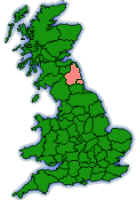
Newcastle is in the North East of England in the
Tyne and Wear region. This area is designated as that between the two rivers named,
surprisingly enough, the Tyne and the Wear. The Tyne is the more Northern of the two.
Newcastle’s about 100 miles south of the Scottish border and 10 miles from the East
coast of the UK (Whitley Bay being the major nearby seaside town).
News of its wonderfulness has spread far and wide, though. This article is word for
word from the Atlanta Journal/Atlanta Constitution dated Sunday August 6th 1995. You can
check it out
from the paper’s morgue if you like - it’s from the Travel section:
Top Party Towns
Are you ready to party?
- Then maybe you should head for New Orleans which tops a survey by Weissman Travel
reports of the world’s best party towns. ‘No explanation needed,’ says
editor Arnie Weissman. ‘There’s always a party going on.’
- Amsterdam, Netherlands. Bars and night clubs galore.
- Rio de Janeiro, Brazil. During carnival, some wear intricate costumes. Some wear almost
nothing.
- Las Vegas. With a little luck at the tables, your partying will cost you nothing.
- Newcastle, England. Says Weissman: ‘Countless pubs connect like shops in a
mall.’
Hey, fifth isn't bad against places like that, is it?
Area
No actual numbers available, but not infinite by
any large stretch of the imagination. Many areas are classed as Newcastle so it depends on
what you mean by "City of..." or "Borough of..". The city centre is
relatively small as far as cities go, and has a lovely cross-section of all types of shops
and so forth. The borough also has an amazing cross-section and stretches as far south as
the River Tyne (Gateshead is on the other side), as far north as the border with
Northumberland (about 15 miles from Tyne to Northumberland), as far east as Wallsend (or
thereabouts) and as far west as Newcastle Airport.
Exports
 | 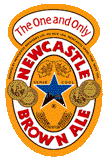 Newcastle Brown Ale - Probably the most popular and widely-available alcoholic beverage in
the UK. And the US’s equivalent of Sol Lager from what I hear (i.e., bloody expensive
to import, but all the "happening" people drink it. What’s actually
"happening" to them is a different matter, but after four bottles of Dog (as
it’s affectionately known), it usually involves soiled underwear and several angry
policemen). Newcastle Brown Ale - Probably the most popular and widely-available alcoholic beverage in
the UK. And the US’s equivalent of Sol Lager from what I hear (i.e., bloody expensive
to import, but all the "happening" people drink it. What’s actually
"happening" to them is a different matter, but after four bottles of Dog (as
it’s affectionately known), it usually involves soiled underwear and several angry
policemen). |
 | Sting - born on Tyneside under the original title of Gordon Matthew Sumner.
An ex-schoolteacher who turned singer. Some people never change... He was bass player and vocalist for The
Police, a popular band in the 80’s. The formation of this band led to the now-tired,
but then-hilarious joke: |
Prospective employer: have you got a police record?
Prospective employee: yes - "Walking on the Moon"
He also claims that through Yogic techniques he can last for around 5 hours in bed. This
is understandably considerate of a Geordie, as we all know that few lasses can last as
long as we usually do.
 | Ships - Boats (pronounced "bo-ats") have been built on the Tyne for
well over a hundred years. Unfortunately, the government has seen fit to close down most
of the shipyards resulting in massive amounts of unemployment and the next export: |
 | ‘Geordies’ - Friendly
folk with a language all of their own. The definition of a Geordie differs slightly from
area to area, the quaintest being "anyone born within sight of the Tyne," but
extending to "anyone born in the North East of England." This gives the
‘Mackems’ an easy way out by claiming they live "near Newcastle"
instead of "in Sunderland." Geordies and Mackems get on like a box of matches
and a large pile of explosives... On *no account* walk around Newcastle in a red and white
vertically- striped soccer shirt. Unless you enjoy being beaten to a pulp by a rampaging
mob of followers of Newcastle’s Black and White Army (a.k.a. Newcastle United
Football Club) |
Weather
Generally cold and wet, though when the sun does
come out it can be enough to make your freckles slide off with the sweat. The
weather tends to stick to the usual British rota of hot weather in summer and colder in
winter though expect to see snow as late on as March.
Monetary Units
The Pound Sterling. Expect many places to
complain about having to accept any foreign currency including Scottish banknotes.
Newcastle’s quite a cheap place to both live in and visit, nightclubs being the
exception to this rule.
Art
Newcastle has three cinemas and four theatres in
the town centre, as well as two museums. Cinema wise, you have the nine-screen Warner
multiplex in Manors, five minutes from the town centre. Always a good selection of films
and relatively cheap to get in. The Odeon is about one minute from the middle of the town
as is the Tyneside Cinema. The Odeon is a four-screen affair, and the prices are about the
same as the Warner. The Tyneside is Newcastle’s "art-house" cinema that
tends to show the cult films and runs seasons of various kinds. Also, if you’re
prepared to skip over the river slightly and head for MetroCentre there’s the UCI
multiplex.
Theatres in the town centre are the Playhouse (small and charitably funded but a lovely
place), the ‘Theatre Royal, the City Hall, and the Tyne Theatre and Opera House. All
are nice venues and have a good range of ticket prices for whatever show is performing.
The City hall is the only one that doubles as a concert venue.
Other concert venues are the Mayfair (also a nightclub), the Riverside, Newcastle
University, and many pubs for local bands including the legendary Broken Doll. The Doll is
soon to be part of a bypass. Well, it’s progress, isn’t it? Other nearby places
for concerts and so forth are Middlesborough (Arena), Whitley Bay (ice rink) and Gateshead
Stadium. Newly opened is the somewhat long-overdue Newcastle Arena. It holds around 10,000
people with parking for around 300 ears (if memory serves). It seems that they’re
relying on people using the public transport system, then. The Arena is located just off
the Redheugh Bridge on the left as you’re heading into Newcastle from Gateshead.
The three museums in the city centre are the Hancock (near the Haymarket), the Joicey
(near Manors) and the Discovery (near the Central Station). All are free to get in, though
I believe a charge is occasionally made to view some of the larger exhibits. The Hancock
has themed exhibitions that last for several months. Very popular, so aim to go out of
peak season if you can.
The Discovery museum houses a lot of mechanical and engineering exhibits, the Time Tunnel, and
some science experiments for kids of all ages to play with!
The Joicey is more of a local affair with more permanent exhibits. Dealing more with
local history (but not exclusively - it takes this link rather tenuously to show things from other
countries discovered by Geordies) it’s very cheap to get into and larger than it
looks from the
outside. Truly theTARDIS of Northern Museums.
"A grand
day out in and around Newcastle".
 | The Tyne Bridges 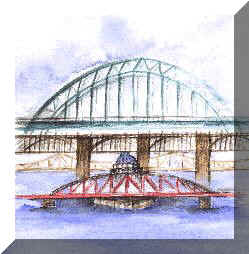 |
Of all the sights in Newcastle, the most famous view is that of the six bridges
which cross the River Tyne. Royalty has opened all the bridges, but the three best known
have also led the way for different designs worldwide. The most famous is the Tyne Bridge,
but this symbol of Tyneside is the youngest of the three great bridges. It was built in
1925-28 and opened by King George V. Almost ½ a mile long, it was the worlds largest span
bridge at the time until its famous cousin was opened in Sydney Australia in 1932
Just upstream, the Swing Bridge stands ion the line of the original Roman
Bridge (Pons Aelius). Since the Roman legions built Pons Aelius there has always been a
bridge at his point including a medieval bridge with houses on it, which was swept away in
the Great Flood of 1771. The Swing Bridge was built by Sir W G. Armstrong and opened in 1
876. It swivels about its centre point on huge roller bearings and is operated by
hydraulic pressure.
The High Level Bridge, which is further upstream again, was the world’s
first road and railway bridge. The railway is carried above and the road below. It as
designed by Robert Stephenson and combines cast and wrought ironwork arches carried on
stone piers. Queen Victoria opened it in 1849.
 | The Town Walls |
Stout walls that ringed the town once defended Newcastle. Parts of these still
survive and include a number of towers that were built at regular intervals.
Begun in 1265, the Walls were completed about the mid-fourteenth century and
encompassed the whole of Medieval Newcastle. The Walls ran for two miles from the east of
Quayside and encircled the town returning to Quayside and joining the riverside where the
Copthorne Hotel now stands.
 | The Castle Keep |
Robert Curthose, the bastard son of William the Conqueror, built the "New
Castle", from which the City took its name, in 1080. The original Castle was made
from wood and built on the site of the Roman fort of Pons Aelius. The Castle was entirely
rebuilt in stone between 1168 - 1172 by Henry 11. The present Keep, one of the finest
examples of this type of Norman military architecture, dates from this rebuilding although
there are some later modifications, particularly the roof and battlements, added early in
the nineteenth century by John Dobson.
 | Earl Grey’s Monument |
Standing in the very centre of Newcastle is the magnificent monument to Earl
Grey. Built in 1837-38, the 135 feet high column commemorates the passing of the Great
Reform Act of 1832 when Earl Grey was Prime Minister. It is a particularly good spot from
which to see the extent and quality of the classical development of the City centre
carried out by John Dobson and Richard Grainger from the 1830’s onwards.
 | Heritage Trail |
Newcastle’s Heritage Trails are a great way to explore the City in easy
stages. Four Trails cover various aspects of the City’s history, The Wall, Station,
Classical and Churches Trails each follows a central theme and take between one and one
and a half hours to walk. A leaflet with a map and explanatory text accompanies each
Trail, these are available, for a small charge, from City and Tourist Information Service
offices in the Central Library and Central Station.
 | Bede’s World |
Bede’s world is a spectacular new attraction that tells the story of early
Christianity and illustrates the life of the eighth century monks who made Jarrow the
European centre of culture. The most brilliant and famous scholar and historian of early
medieval Europe, the venerable Bede, spent much of his life in Jarrow at the monastery of
St Paul. Bede’s world tells the story of the Golden Age of Northumbria where Celtic
and Roman traditions combined to produce world famous works of an. An 11-acre farm
re-creating the environment, agriculture and life of the times is being created which
features experimental reconstruction of timber buildings of the period and species of
crops, animals, grass land and trees from those ancient times.
Bede’s world, Church Bank, Jarrow, NE32 3DY. (0191 489 2106).
 | Sea Life Centre |
The Sea Life Centre features one of those amazing tunnels that allow you to get
as close to the sea life as possible, without getting wet! The centre allows an intriguing
insight into the area’s rich maritime history and the wealth of sea creatures living
off the Northeast coast of Britain. From sharks to shrimps a number of high tech displays
bring you incredibly close to the wonders of British marine life.
Sea Life Centre, Promenade Coast Road, Beaconsfield,
Tynemouth. NE3O 441 (0191 257 6100)
Click on flag
for information about Northumbria
:
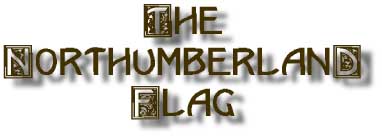 
     

|
 ENGLAND
ENGLAND 